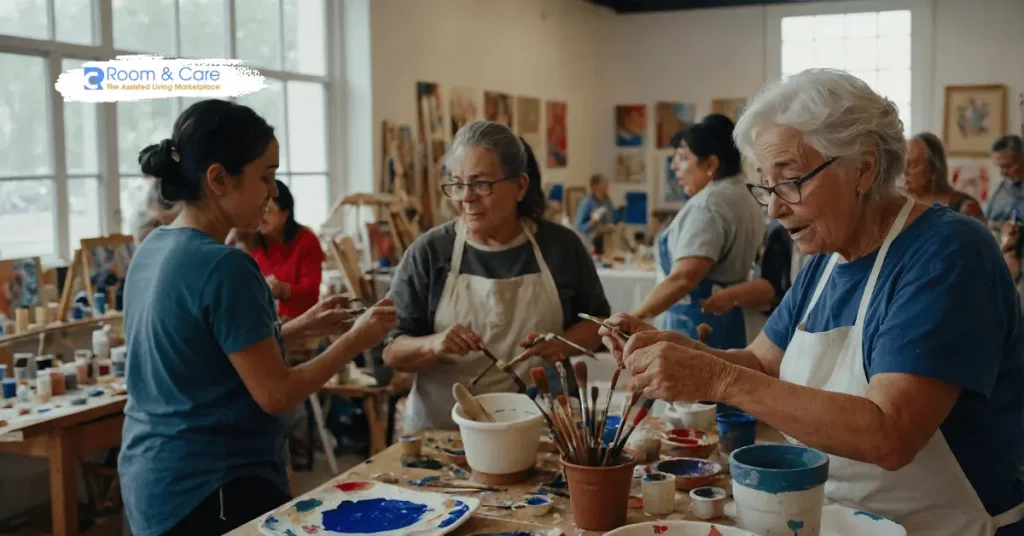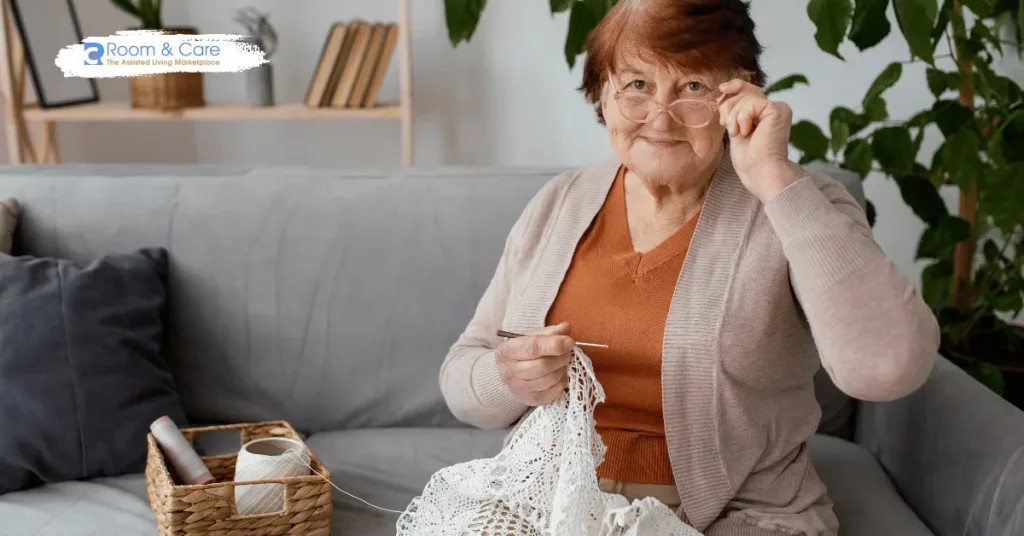

Engaging in craft activities can be immensely rewarding for seniors, providing both mental stimulation and a sense of accomplishment. In this comprehensive guide, we’ll explore a variety of crafts for seniors, discuss the benefits of these activities, and provide practical tips to help seniors get started. Whether you’re looking for ideas for yourself, a loved one, or residents in an assisted living facility, nursing home, or other assisted living homes, you’ll find valuable insights here.
Craft activities are not just a pastime; they offer numerous benefits that contribute to the well-being of seniors. Engaging in creative projects can help improve cognitive functions, enhance motor skills, and provide emotional satisfaction. For seniors residing in assisted living facilities, nursing homes, adult family homes or other assisted living homes, craft activities can also foster social interaction and a sense of community.
Crafting requires concentration, problem-solving, and memory recall, which can help keep the mind sharp. Studies have shown that engaging in creative activities can reduce the risk of cognitive decline and dementia. For example, a study published in the “Journal of Neuropsychiatry and Clinical Neurosciences” found that seniors who participated in crafts had a lower risk of developing mild cognitive impairment.
Many craft activities involve fine motor skills, which can be beneficial for seniors. Activities like knitting, painting, or woodworking can help maintain hand-eye coordination and dexterity. This is particularly important for seniors as it can help them remain independent in their daily tasks.
Crafting can be a therapeutic activity that reduces stress and promotes relaxation. It provides a sense of accomplishment and can boost self-esteem. Additionally, group craft activities in assisted living facilities or nursing homes can help seniors build social connections, reducing feelings of isolation and loneliness.
Knitting and Crocheting: These classic crafts are perfect for seniors. They can create beautiful scarves, blankets, and hats while keeping their hands busy. Plus, knitting and crocheting can be done individually or in groups, making it a versatile activity.
Painting and Drawing: Whether it’s watercolor, acrylic, or sketching, painting and drawing allow seniors to express their creativity. These activities can be adapted to different skill levels, and the final artwork can be displayed, boosting confidence and pride.
Scrapbooking: Creating a scrapbook is a wonderful way for seniors to preserve memories and stories. They can use photos, mementos, and decorative papers to create personalized books that they can share with family and friends.
Jewelry Making: Making jewelry can be a fun and rewarding activity. Seniors can create necklaces, bracelets, and earrings using beads, wire, and other materials. This craft can also be a great way to make personalized gifts for loved ones.
Woodworking: For seniors who enjoy working with their hands, woodworking can be a fulfilling hobby. They can create simple projects like birdhouses, picture frames, or small furniture items.
Assisted living facilities, nursing homes, and other assisted living homes often have dedicated activity coordinators who plan and facilitate craft sessions. These activities not only keep residents engaged but also promote social interaction and a sense of community.
Group Mural Projects: Creating a mural as a group can be a fun and collaborative activity. Each resident can contribute their own piece, and the final mural can be displayed in a common area, adding a personal touch to the facility.
Seasonal Crafts: Celebrating holidays and seasons with themed crafts can bring joy and a sense of festivity. For example, making ornaments during the winter holidays or creating floral arrangements in the spring.
Art Therapy Sessions: Art therapy can be particularly beneficial for seniors with cognitive impairments or emotional challenges. Guided by a trained therapist, these sessions can help residents express their emotions and improve their well-being.
Ceramics and Pottery: Working with clay can be a soothing and satisfying activity. Seniors can create functional items like bowls and mugs or decorative pieces like sculptures and tiles.

Choose Appropriate Projects: Select crafts that match the skill levels and interests of the seniors. Ensure that the materials and tools are safe and easy to use.
Provide Clear Instructions: Offer step-by-step guidance and demonstrations to help seniors understand the process. Visual aids and examples can be very helpful.
Encourage Creativity: Allow seniors to express their individuality and creativity. Encourage them to experiment with colors, materials, and designs.
Create a Comfortable Environment: Ensure that the crafting area is well-lit, comfortable, and accessible. Provide adequate seating and workspace for everyone.
Foster a Social Atmosphere: Promote social interaction by organizing group activities and encouraging conversations. Crafting together can be a great way for seniors to bond and make new friends.
When planning craft activities for seniors, especially in assisted living facilities or nursing homes, there are several important considerations to keep in mind.
Accessibility: Ensure that the crafting materials and tools are easily accessible to all participants. This includes providing adaptive tools for those with limited mobility or dexterity.
Safety: Safety is paramount. Avoid sharp or hazardous materials and supervise activities to prevent accidents. Ensure that the crafting area is free of tripping hazards and other potential dangers.
Engagement: Choose activities that are engaging and meaningful. Consider the interests and preferences of the participants to keep them motivated and enthusiastic.
Inclusivity: Make sure that all residents feel included and valued. Adapt activities to accommodate different skill levels and abilities, and provide additional support as needed.
When deciding on craft activities for seniors, consider the following factors:
Interests and Preferences: Take into account the hobbies and interests of the seniors. Personalized activities are more likely to be enjoyable and engaging.
Cognitive and Physical Abilities: Assess the cognitive and physical abilities of the participants. Choose activities that are challenging yet achievable to ensure a sense of accomplishment.
Resources and Budget: Consider the available resources and budget for crafting materials. Many activities can be done inexpensively using recycled or donated materials.
Group Size and Dynamics: Plan activities that are suitable for the group size and dynamics. Some projects may be better suited for small groups, while others can be done with larger groups.
Craft activities that are simple, repetitive, and familiar can be beneficial for seniors with dementia. Examples include coloring, clay modeling, and sensory-based crafts like making tactile collages.
Encourage participation by choosing activities that align with their interests and abilities. Provide positive reinforcement and create a supportive environment. You can also join in the activity to make it a shared experience.
Yes, there are many online resources, including websites, blogs, and YouTube channels, that offer a wealth of craft ideas for seniors. These resources can provide step-by-step instructions, tutorials, and inspiration.
Absolutely. Craft activities can reduce stress, improve mood, and provide a sense of purpose and accomplishment. They can also serve as a form of therapy for seniors dealing with anxiety, depression, or other mental health issues.
Ideally, seniors should engage in craft activities several times a week to gain the most benefits. However, even occasional crafting can provide positive effects. The key is to find a routine that works best for the individual and their schedule.
The best materials for senior craft activities are those that are easy to handle and safe to use. Common materials include paper, fabric, beads, clay, paint, and wood. It’s also beneficial to use non-toxic and hypoallergenic supplies, especially for seniors with sensitivities or allergies.

Assisted living facilities are ideal environments for promoting craft activities. These facilities often have dedicated spaces for arts and crafts, complete with all the necessary supplies. Activity coordinators can plan and lead sessions, ensuring that residents are engaged and supported. Here are some examples of how craft activities can be integrated into daily life in assisted living facilities:
Themed Craft Days: Organize themed craft days based on holidays, seasons, or special events. For instance, making Valentine’s Day cards, Easter decorations, or patriotic crafts for the Fourth of July.
Collaborative Projects: Encourage residents to work together on larger projects, such as quilts, murals, or garden decorations. Collaborative projects can foster a sense of community and teamwork.
Skill-Building Workshops: Offer workshops to teach new crafting skills, such as knitting, painting, or woodworking. Bringing in local artists or hobbyists to lead these workshops can provide residents with fresh perspectives and techniques.
Display and Exhibitions: Create opportunities for residents to showcase their work. Organize art shows or create display areas within the facility where residents’ crafts can be admired by visitors and fellow residents.
Nursing homes can also provide enriching craft activities tailored to the needs of their residents. Here are some tips for implementing successful craft programs in nursing homes:
Adaptable Activities: Choose crafts that can be easily adapted to suit different abilities. For example, offering both simple coloring projects and more complex painting activities.
Sensory Crafts: Incorporate sensory elements into craft activities, such as using textured materials or scented paints. This can be particularly beneficial for residents with sensory impairments or cognitive challenges.
Memory-Inspired Crafts: Engage residents in activities that draw on their memories and experiences. Scrapbooking, storytelling through art, and creating memory boxes can be deeply meaningful.
One-on-One Sessions: Provide opportunities for one-on-one crafting sessions for residents who may need extra assistance or prefer a quieter environment. Personalized attention can make a significant difference in their engagement and enjoyment.
Adult family homes, which offer a more intimate living environment, can also integrate craft activities into daily routines. Here are some ways to incorporate crafting in adult family homes:
Daily Craft Time: Establish a regular daily or weekly craft time where residents can gather to create and socialize. Consistency can help make crafting a cherished part of the routine.
Outdoor Crafts: Take advantage of outdoor spaces by incorporating nature-inspired crafts. Activities like painting garden pots, creating bird feeders, or making leaf prints can connect residents with the outdoors.
Intergenerational Projects: Involve family members or community volunteers in craft activities. Intergenerational projects can be incredibly rewarding and provide additional social interaction.
Customized Crafts: Tailor craft activities to the specific interests and abilities of the residents. Personalized projects are more likely to engage and satisfy participants.
Craft activities offer a multitude of benefits for seniors, from enhancing cognitive and physical abilities to providing emotional satisfaction and social interaction. Whether at home or in assisted living facilities, nursing homes, or other assisted living homes, seniors can enjoy a variety of crafts that cater to their interests and abilities.
For more information on finding the best assisted living facilities, adult family homes, memory care facilities, nursing homes, and independent living communities, visit Room and Care. Room and Care offers these services with no referral fee or middlemen, ensuring direct access to the best care options while reducing costs. Explore our website to find the perfect facility that meets your needs and preferences.
Engage in the joy of crafting today and experience the positive impact it can have on your well-being and quality of life. Happy crafting!